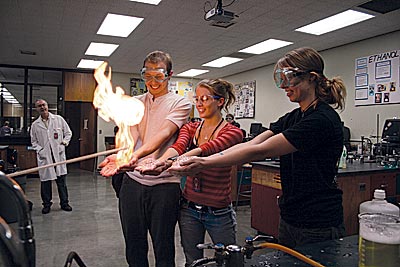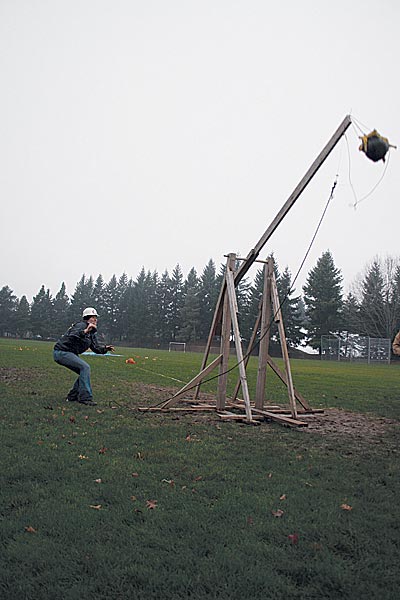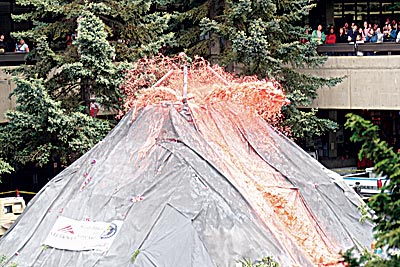Venture
June 2008



Lords of the lab
Grant-funded science students use their resources
to link the public to their passions and hobbies
One would have had to studying under a rock this school year to not have seen the massive presence the Mt. Hood Community College Science Club has had on campus.
Officers of the club give credit for the flying pumpkins, deafening explosions and a record-breaking volcano to the freedom they were afforded by an internship program known as UCORE.
“The Science Club hasn’t had very many big events in the past and UCORE jump-started our involvement in the Science Club,” said Eric Hyde, mechanical engineering major and club vice president. “Other people have become more involved after seeing how much fun the club is having and hopefully they will continue to be as active.”
UCORE (Undergraduate Catalytic Outreach and Research Experiences) is a grant-funded program organized through the University of Oregon that provides students with internship opportunities both during the school year and the summer. Summer interns are given a flat stipend but those working during the school year are paid hourly.
Hyde, Elizabeth Anderson, Trishia Hisey, and Theo Malone were the students accepted into the program from MHCC and the four were given the task of designing projects that would create both interest in and understanding of science within the community.
“Science is life and life is science,” said an out-of-breath Malone, club president, after completion of their most arduous task of the year: the world’s largest baking soda and vinegar volcano completed June 4. Looking down at the strips of duct tape covering cuts and blisters on his fingers, he added, “Vinegar hurts in cuts. Go figure.”
Malone said he had wanted to try to break a record while he was leader of the club and said the idea for the volcano came out of group discussions for what would be both time and cost effective. Scaffolding and PVC was donated by local businesses, and student volunteers joined club members during the volcano’s month-and-a-half construction time.
“The volcano was definitely my favorite,” said Hyde. “First it was massive, second it required massive teamwork and third, it allowed me to use my engineering design skills (that he said he has informally gathered ).”
The club started in November with large-scale projects, constructing a trebuchet (a medieval war machine) and threw pumpkins across the football field to the amazement of students, administrators and local radio stations. Malone said he had hoped to launch watermelons in the spring with the large throwing arm, but said space issues forced them to move it off campus. (It had been stored next to the abandoned horticulture greenhouse.) But the turnout for the trebuchet event was the beginning of a large fan base that would follow the club through the year.
“This is by far the biggest, most active group,” said Science Club Adviser Michael Russell of the students he has been working with this year. “UCORE gave them a chance to do research and be a little more independent.”
Now that their year is over and the UCORE students will be replaced by other science majors, they say there are few regrets. But there are a few.
“I wish that we could have made the volcano even bigger, maybe renovate a tanker truck or two for the reaction chamber,” said a sardonic Hyde.
“Cryomania” was also on Malone’s to-do list, which would have involved crafting ice cream with liquid nitrogen, but such projects have been left in the hands of next year’s UCORE students.
To incoming members of UCORE and the Science Club, Malone said, “Dream big. Anything you can think of doing is possible if you go about it the right way.”
Venture
June 2008


